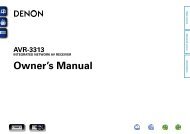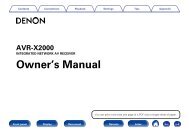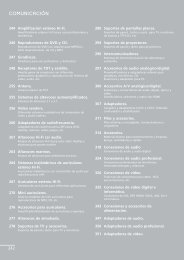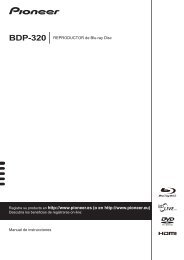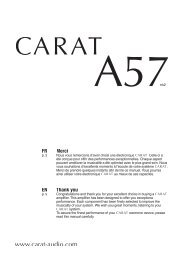You also want an ePaper? Increase the reach of your titles
YUMPU automatically turns print PDFs into web optimized ePapers that Google loves.
Creating Macros<br />
You can program your CR102 to issue a sequence of<br />
commands when you press a single key. Any sequence of<br />
commands you regularly use can be reduced to a single<br />
key press for your convenience.<br />
For example, you might want to turn off your TV, VCR<br />
and Satellite at the same time.<br />
< A key programmed with a Macro is available in all<br />
modes; it will replace that key’s different functions<br />
for all modes.<br />
< A Macro can consist of up to eight key presses.<br />
Example: To assign a Macro to the h key<br />
1. Press and hold S until the power LED blinks twice:<br />
* *.<br />
2. Press 9 9 5.<br />
3. Press h (the Macro will be assigned to this key).<br />
4. Press a, P, w, P, z, P. (These are the Macro<br />
steps you wish to record.)<br />
5. To store the Macro, press and hold S until the<br />
power LED blinks twice: * *.<br />
Now, whenever you press h, the CR102 will toggle the<br />
power to your TV, VCR and Satellite.<br />
< The important word here is ‘toggle’. For example, if<br />
the TV and Satellite devices are currently on, but<br />
the VCR is off, pressing h will switch off the TV<br />
and Satellite and switch on the VCR (rather than<br />
switching all three devices on or off).<br />
< When using Macros, remember that you may need<br />
to change mode or use S, and that each key press<br />
(including changing modes and pressing S) counts<br />
as one of the Macro steps. You cannot use a Macro<br />
key within another Macro.<br />
< If the amount of memory storage for a particular<br />
Macro is exceeded, the power LED comes on for five<br />
seconds. You can, however, save the macro steps up<br />
to that point by pressing S, or you can cancel the<br />
Macro recording by pressing any other key.<br />
< The delay between key presses is recorded as part of<br />
the Macro. A delay of up to 30 seconds is permitted.<br />
Example: To deassign the Macro associated<br />
with the h key<br />
1. Press and hold S until the power LED blinks twice:<br />
* *.<br />
2. Press 9 9 5.<br />
3. Press h.<br />
4. Press and hold S until the power LED blinks twice:<br />
* *.<br />
Volume punch-through<br />
Volume punch-through means that, no matter which<br />
Device Mode is selected, the CR102 controls the<br />
<strong>AVR600</strong> volume. You don’t need to press A on your<br />
CR102; this feature is switched on by default.<br />
There are times, however, when you might want to<br />
control a device’s volume directly when in a specific<br />
Device Mode.<br />
Example: To cancel volume punch-through<br />
for a TV (AV mode)<br />
1. Press a once.<br />
2. Press and hold S until the power LED blinks twice:<br />
* *.<br />
3. Press 9 9 3.<br />
4. Press -. The power LED blinks four times.<br />
Now, while in TV (AV) mode, you will be able to control<br />
the volume or mute functions of your TV directly.<br />
To completely cancel all volume punchthrough<br />
settings<br />
1. Press and hold S until the power LED blinks twice:<br />
* *.<br />
2. Press 9 9 3.<br />
3. Press +. The power LED blinks four times * *<br />
* *.<br />
Now, whichever mode you’re in, you will have direct<br />
access to that device’s volume or mute functions,<br />
assuming they are available. You would need to switch to<br />
AMP mode to alter the <strong>AVR600</strong> volume.<br />
Example: To restore default volume punchthrough<br />
settings to all Device Modes<br />
1. Press and hold S until the power LED blinks twice:<br />
* *.<br />
2. Press 9 9 3.<br />
3. Press A. The power key LED blinks twice: * *.<br />
Key Mover<br />
Sometimes you might find that a key you use a lot for<br />
your system is in the ‘wrong’ place on the CR102 keypad<br />
for your comfort. It’s quite easy to reassign a favourite<br />
function to a more accessible key. It is even possible<br />
to move a function from one Device Mode to another<br />
Device Mode.<br />
Example: To assign the D function to the U<br />
key in SAT mode<br />
1. Press z.<br />
2. Press and hold S until the power LED blinks twice:<br />
* *.<br />
3. Press 9 9 4.<br />
4. Press the key you want to move (e.g. D)<br />
5. Press the key you want to move the key to (e.g. U).<br />
Now, pressing either D or U while in SAT Device<br />
Mode makes the CR102 transmit the D function.<br />
To completely swap over the functionality of the two<br />
keys to put the U functionality on the D key, repeat<br />
the above process again, but swap over the D and U<br />
key presses in the example.<br />
Note that the function that is copied over to the new key<br />
is always the original function of the old key.<br />
Restore a moved key<br />
To restore a key to its previous function, repeat the<br />
example above, pressing the key to be restored twice<br />
(copy it back to itself).<br />
Restore all moved keys for a Device Mode<br />
To restore all keys in a Device Mode to their original<br />
functional positions, repeat the example above, but press<br />
the relevant Device Mode key (e.g. A ) at points 1,4 and<br />
5 in the example.<br />
English<br />
E-51



